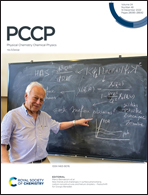Understanding the oxygen-evolution-reaction catalytic activity of metal oxides based on the intrinsic descriptors†
Abstract
Metal oxides show great potential in catalyzing the oxygen evolution reaction (OER), which is taken as the bottleneck of many energy-conversion and -storage processes. However, it is still a major challenge to deeply understand the catalytic mechanism and to rapidly screen out novel metal–oxide catalysts. Herein, we find that the trend of adsorption energies of O-intermediates and the theoretical overpotentials on metal monoxides (MO), metal dioxides (MO2), and perovskite oxides (ABO3) can be determined using the descriptor ψ, which is related to the valence-electron numbers and the electronegativities of the active center. The underlying mechanism is that ψ reflects the p-band properties of superficial and adsorbed O atoms of metal oxides and thus can reveal the commonality and difference of adsorption and catalysis of the three types of metal oxides. Moreover, the ψ-determined relationships indicate the possibility of breaking the previously proposed thermodynamic limitation on the post-transition metal oxides and rationalizing the trend of experimental OER catalytic activity of metal oxide catalysts. With this easily accessible intrinsic descriptor ψ, we provide a convenient and feasible scheme for designing new candidates for OER catalysts.



 Please wait while we load your content...
Please wait while we load your content...